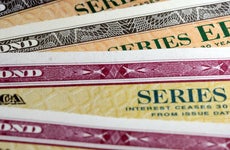What is an American depositary receipt (ADR)?

The Bankrate promise
At Bankrate we strive to help you make smarter financial decisions. While we adhere to strict , this post may contain references to products from our partners. Here's an explanation for .
Our writers and editors used an in-house natural language generation platform to assist with portions of this article, allowing them to focus on adding information that is uniquely helpful. The article was reviewed, fact-checked and edited by our editorial staff prior to publication.
American depositary receipts (ADRs) can be a way to gain exposure to foreign stocks while still trading on the U.S. stock market. In other words, investors can own foreign stock without having to directly invest in foreign exchanges.
Here’s how ADRs work, the different types of ADRs and the advantages and disadvantages for investors.
How do American depositary receipts work?
ADRs are documents provided by U.S. banks that allow U.S. investors to own foreign stock. They trade on American stock markets, such as the New York Stock Exchange (NYSE) or Nasdaq, and are valued in U.S. dollars. The first ADR debuted in 1927 for Selfridges, a British clothing company, and was originally created by the predecessor of JPMorgan Chase.
A custodian bank issues ADRs when the underlying shares are deposited in a foreign custodian bank. ADRs may represent a fraction or multiple shares of or an entire share of a foreign security.
ADRs simplify foreign investing for U.S. investors by eliminating the need to navigate foreign stock markets and transact in foreign currencies. The depositary bank handles storage, currency conversion and local tax issues for ADR holders.
Example of investing in ADRs
Suppose you want to invest in Petrobras, a Brazilian energy company, but are concerned about the additional complexities of investing in foreign companies. You can invest in Petrobras ADRs, which are equity securities issued by a U.S. bank (JPMorgan Chase Bank in this case) traded on the NYSE under PBR and PBRA.
Two more examples of foreign companies that issue ADRs in the U.S. include Vodafone and Alibaba, but there are thousands to choose from.
“While they may be classified as ADRs, foreign-listed companies can trade like the real thing on a U.S. exchange,” says James Royal, principal writer on investing, Bankrate. “An ADR typically provides American investors with greater liquidity and it means investors don’t need to buy the stock on a foreign exchange, with the increased costs and other hassles that may entail.”
Types of American depositary receipts
ADRs can be categorized into sponsored and unsponsored ADRs.
Sponsored ADRs
When a foreign corporation goes public in the U.S. market, it often creates ADRs to help financial institutions and other interests access its offering. If the non-U.S. company makes an agreement with a U.S. bank for ADRs, it’s “sponsored” by that bank. The sponsoring bank handles the recordkeeping, paperwork and dividend payments.
Unsponsored ADRs
Unsponsored ADRs, on the other hand, are created without the cooperation of the foreign company and may not meet Securities and Exchange Commission (SEC) requirements.
Additionally, ADRs are classified into three levels.
Level I
Level I ADRs are traded over the counter and cannot be listed on an exchange or used to raise capital for the non-U.S. company. Level I ADRs are also not required to provide ongoing financial disclosure reports to investors. The company may choose to provide its annual report or other information voluntarily, but you won’t find disclosures and other information on the SEC’s website. ADRs at this level may be the riskiest and most speculative. This is also the only level where ADRs can be unsponsored.
Level II
Unlike Level I, Level II ADRs can be listed on a U.S. stock exchange, but similar to Level I, the ADRs can’t be used to raise capital. Level II ADRs are sponsored and have more regulatory requirements, including registration with the SEC and publishing annual financial reports. However, Level II ADRs are still exempt from certain reporting requirements.
Level III
Level III ADRs have the strictest regulations and filing requirements, with SEC reporting similar to domestically traded companies. At this level, the issuing foreign company is allowed to be listed on a U.S. exchange and raise capital.
ADR advantages
Here are some of the upsides to investing in ADRs:
- Convenient access to foreign markets
- An ADR provides foreign stock exposure through U.S. brokers and is denominated in U.S. dollars.
- Easier trading and tracking
- ADR trading is cleared through U.S. settlement systems. This means that ADRs are easy to trade and track, eliminating foreign taxes, currency conversions and direct communication with foreign companies.
- Portfolio diversification
- Investors can diversify their portfolios with international stocks using ADRs.
- Lower minimums
- Investors may be able to buy shares of some foreign companies that trade as ADRs with lower minimums than they would be able to if the stock traded in a foreign country.
ADR disadvantages
While there are a number of advantages, ADRs come with some downsides. Here are a few:
- Double taxation risk
- The foreign company may withhold taxes from dividends leading to potential complications in claiming tax credits.
- Limited availability
- Many popular foreign companies don’t offer ADRs, so investors who want to own those stocks must go through an additional layer of complexity.
- Exchange rate risk
- The foreign country’s currency could weaken against the U.S. dollar.
- Potential fees
- ADRs generally come with custody fees, which can vary and should be checked out in the ADR’s prospectus.
Bottom line
ADRs can offer cost-effective and secure ways to invest in foreign companies, and provide several advantages, including low-cost access to foreign markets and simplified taxation. Depending on the ADR, they can be sponsored or unsponsored, and each has different benefits. Ultimately, ADRs could be an attractive option for investors looking to diversify their portfolios.
Related Articles



